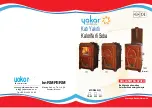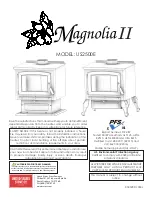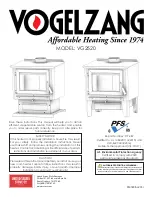
23
Type
Kg/mc
kWh/kg humidity 20%
Beech
750
4,0
Turkey oak
900
4,2
Elm
640
4,1
Poplar
470
4,1
Larch*
660
4,4
Norway spruc
e
*
450
4,5
Scotch pine*
550
4,4
*
RESINOUS WOOD UNSUITABLE
CAUTION: The continuous and prolonged used of wood which is particularly rich in aromatic oils (e.g. Eucalyptus, Myrtle etc.)
causes the sudden deterioration (flaking) of the cast iron components present in the product.
9. IGNITION
WARNING: For no reason turn on the fire before the system has been completely filled with water; doing this would lead serious
damage to the entire structure. IABSOLUTELY DO NOT LIGHT THE FIRE IN THE THERMO-FIREPLACE IN THE TOTAL OR
PARTIAL ABSENCE OF WATER
(NOT EVEN FOR CHECKING), AS IT COULD BE IRREMEDIABLY RUINED. IN SUCH CASE THE
WARRANTY ON THE APPLIANCE IS VOIDED.
IMPORTANT
: during the first ignition, it is inevitable that an unpleasant smell is produced (due to the drying of the adhesives in the sealing
cord or the protective varnishes), which disappears after a short use.
The environment must nevertheless be well ventilated.
On
first ignition, we recommend loading a reduced quantity of fuel and increasing the calorific power of the appliance.
ATTENTION
:
during the first lightings there could be a solid smokes condensation with a small escape of water from the thermo-
fireplace: this event will expire in a very short time but if it persists it will be necessary to check the chimney draught.
To carry out a correct first ignition of the products treated with varnishes for high temperatures, it is necessary to know the following
information:
• the construction materials of the products in question are not homogeneous; in fact cast iron and steel parts exist side by side.
• the temperature to which the body of the product is subjected is not homogeneous: from zone to zone, the temperatures recorded
vary from 300 °C to 500 °C;
• during its life, the product is subjected to alternate cycles of ignition and switch-off during the same day and to cycles of intense
usage and complete rest as the seasons change;
• the new thermocooker, before it can be defined as “tested”, must be subjected to various start up cycles in order to allow all the
materials and the varnish to complete the various elastic stresses;
• in particular at the beginning, it is possible to notice the emission of smells which are typical of metals subjected to great thermal
stress and varnish which is still fresh. This varnish, despite being baked at 250°C for a few hours in the manufacturing process,
must exceed the temperature of 350°C several times and for a certain duration, before incorporating itself perfectly with the metal
surfaces
It therefore becomes important to follow these small precautions in the ignition phase:
1. Make sure that there is significant air turnover in the place where the appliance is installed.
2. When lighting for the first few times, do not load the combustion chamber excessively (about half of the quantity shown in the
instruction manual) and keep the product lit for at least 6-10 hours continuously, with the registers open less than shown in the
instruction manual.
3. Repeat this operation at least 4-5 times, according to your availability.
4. Subsequently load more (nevertheless following the descriptions in the instruction booklet regarding the maximum load) and if
possible, keep ignition periods long, at least in this initial phase, avoiding short on-off cycles.
5. When lighting for the first few times, no object must be placed on the thermocooker and in particular on enamelled surfaces. Enamelled
surfaces must not be touched during heating.
6. Once the “testing” phase has passed, it is possible to use your product like you would a car engine, avoiding abrupt heating with
excessive loads.
To ignite the flame, it is advisable to use small panels of wood with paper or other means of ignition on the market, excluding all liquid
substances such as alcohol, petrol, oil etc.
Follow the instructions below:
• Open the ignition register to aid flue gas exhaust. Position the register
pos.
E
(any butterfly valve placed on the
flue gas exhaust pipe must also be opened) as shown in paragraph
• Position the thermostat knob on position 5 (maximum opening).
• Open the primary air register (placed on the ash tray).
• After having started the fire with small pieces of wood and waited until it is well lit, adjust the thermostat to the positions corresponding
to the desired heat.
















































